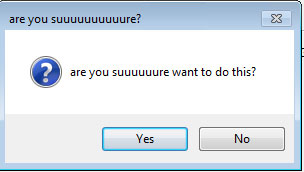Ransom.MSIL.CRAPSOM.THCODBA
Trojan-Ransom.FileCrypter(IKARUS); Troj/Ransom-GFJ(SOPHOS_LITE)
Windows


Threat Type: Ransomware
Destructiveness: No
Encrypted: Yes
In the wild: Yes
OVERVIEW
This Ransomware arrives on a system as a file dropped by other malware or as a file downloaded unknowingly by users when visiting malicious sites.
It encrypts files found in specific folders.
TECHNICAL DETAILS
Arrival Details
This Ransomware arrives on a system as a file dropped by other malware or as a file downloaded unknowingly by users when visiting malicious sites.
Other Details
This Ransomware does the following:
- It displays the following as ransom note:

- It displays the following when trying to exit the ransom note:

- It deletes the encrypted files after clicking on the yes button then displays the following:

It terminates itself if any of the following file(s) are present:
- C:\protect.dat
Ransomware Routine
This Ransomware encrypts files found in the following folders:
- %User Profile%\Documents
- %User Profile%\Desktop
(Note: %User Profile% is the current user's profile folder, which is usually C:\Documents and Settings\{user name} on Windows 2000(32-bit), XP, and Server 2003(32-bit), or C:\Users\{user name} on Windows Vista, 7, 8, 8.1, 2008(64-bit), 2012(64-bit) and 10(64-bit).)
It avoids encrypting files with the following strings in their file name:
- desktop.ini
- Thumbs.db
It appends the following extension to the file name of the encrypted files:
- .crap
SOLUTION
Step 1
Trend Micro Predictive Machine Learning detects and blocks malware at the first sign of its existence, before it executes on your system. When enabled, your Trend Micro product detects this malware under the following machine learning name:
- Troj.Win32.TRX.XXPE50FFF042
Step 2
Before doing any scans, Windows 7, Windows 8, Windows 8.1, and Windows 10 users must disable System Restore to allow full scanning of their computers.
Step 3
Scan your computer with your Trend Micro product to delete files detected as Ransom.MSIL.CRAPSOM.THCODBA. If the detected files have already been cleaned, deleted, or quarantined by your Trend Micro product, no further step is required. You may opt to simply delete the quarantined files. Please check the following Trend Micro Support pages for more information:
Step 4
Restore encrypted files from backup.
Did this description help? Tell us how we did.

